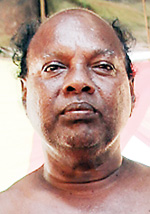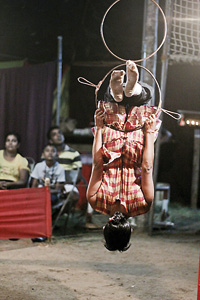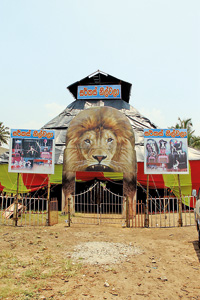 |
| Ariyadasa |
Throughout centuries and across civilizations, humans have relied on each other for spectacle and entertainment. From the nomadic gypsy performers of the Rajasthani deserts to the crowd-pleasing gladiators in the roaring stadiums of Ancient Rome, the universal desire to enthral an audience endures. It is said that during the Kandyan era, each kingdom possessed a personal troupe whose role was to amuse and mesmerize. Now just a handful of circus performers continue their traditions, sacrificing the comforts of a home in exchange for a lifestyle based on dedication to a craft.
One such travelling circus called Circus Neevala set up camp in preparation for the 12 performances they would hold in Panadura recently. When the Sunday Times visited members of Circus Neevala were building the wooden bleachers, that serve as seats, under the illuminated glow of lime green and cherry red that reflected off the thick, vertical candy stripes of the tarpaulin tent.
 Based in Sri Lanka, Circus Neevala first caught the attention of audiences over half a century ago. Their theatrical style and live, original music inspired by traditional Sri Lankan melodies have put Circus Neevala on the map of circus fans nationwide. Based in Sri Lanka, Circus Neevala first caught the attention of audiences over half a century ago. Their theatrical style and live, original music inspired by traditional Sri Lankan melodies have put Circus Neevala on the map of circus fans nationwide.
Vidanarachchige Ariyadasa, the manager of Circus Neevala, was born and raised in the circus industry. He began working with Circus Neevala more than three decades ago when he first stepped into the circus ring as a trapeze artist.
Ariyadasa shares a stack of photographs that exhibit the variety of acts Circus Neevala performs, including unicycling, tightrope walking, and knife throwing. Amidst the photographs is a snapshot of two youthful trapeze performers suspended upside down at a 45-degree angle, captured in mid-swing.
“That’s me and my wife,” Ariyadasa casually mentions, pointing at the snapshot, “We met at Circus Neevala.”
Ariyadasa kindly agreed to an interview with the assistance of a Sinhala-English translator.
- Do you still fly on the trapeze?
No, I am too old now. I have diabetes. If I do the trapeze, the pressure will kill me! (Laughs.)
- How long have you been involved in the circus industry?
All my life. My father and my grandfather both worked in the circus industry. We are the oldest circus in Sri Lanka. Our original name was Circus Pacifia, but a couple of our ex-performers created their own circus troupe, using our name. They weren’t very good and we didn’t want them to ruin our reputation, so we changed our name to Circus Neevala. Neevala means “blue cloud” in Sinhala.
- The circus lifestyle seems so different from any other. Have you ever considered working in another profession?
 No, I haven’t. If we don’t continue, the travelling circus industry will die out. My children are not planning to become circus performers. Today, there are only six or seven travelling circus troupes in our country. Besides, I’ve been in the circus business my whole life. I’ve never been home for longer than one month at a time. We stay in each town for one month, and usually visit twelve towns per year. And most nights, the tickets are sold out. No, I haven’t. If we don’t continue, the travelling circus industry will die out. My children are not planning to become circus performers. Today, there are only six or seven travelling circus troupes in our country. Besides, I’ve been in the circus business my whole life. I’ve never been home for longer than one month at a time. We stay in each town for one month, and usually visit twelve towns per year. And most nights, the tickets are sold out.
- Does Circus Neevala perform any pre-show rituals?
We have a bit of a run through of the show. Then, we might go to the beach, maybe have some beers… Before the show, the troupe always has a drink together. We are a family. It’s a free life.
n It sounds like a fantastic lifestyle. Many of your performers seem to be in their late teens. Where do you recruit your
performers?
We recruit them at the towns we do shows in. Often, they’ll approach us after a show. I give them a 25-day contact and they perform with us for that time. These freelance performers travel from circus to circus and work for a month, or a couple months, at a time.
- Has Circus Neevala ever used trained animals in shows?
We used to have a leopard, an elephant, and a bear cub. But now because of animal rights laws, we don’t use animals aside from our parrots. Once, our resident bear attacked me. (Lifts his shirt to reveal a scar across his belly and another on his chest.) We bought the bear cub from the Dehiwala Zoo, but he died in 1976 when there was a flood.
Ariyadasa smiles as he recalls a freer era of less legislation - the heyday of the travelling circus. While the traditional travelling circus is a dying art in Sri Lanka, Circus Neevala continues to provide audiences with the opportunity to resurrect dormant childhood desires to run away with a travelling troupe and become as limber as a vinegar-drinking acrobat, to juggle to a tinny waltz emanating from a morning glory-shaped gramophone, and to walk on foamy, old popcorn after the crowd has gone home. |


 Based in Sri Lanka, Circus Neevala first caught the attention of audiences over half a century ago. Their theatrical style and live, original music inspired by traditional Sri Lankan melodies have put Circus Neevala on the map of circus fans nationwide.
Based in Sri Lanka, Circus Neevala first caught the attention of audiences over half a century ago. Their theatrical style and live, original music inspired by traditional Sri Lankan melodies have put Circus Neevala on the map of circus fans nationwide.  No, I haven’t. If we don’t continue, the travelling circus industry will die out. My children are not planning to become circus performers. Today, there are only six or seven travelling circus troupes in our country. Besides, I’ve been in the circus business my whole life. I’ve never been home for longer than one month at a time. We stay in each town for one month, and usually visit twelve towns per year. And most nights, the tickets are sold out.
No, I haven’t. If we don’t continue, the travelling circus industry will die out. My children are not planning to become circus performers. Today, there are only six or seven travelling circus troupes in our country. Besides, I’ve been in the circus business my whole life. I’ve never been home for longer than one month at a time. We stay in each town for one month, and usually visit twelve towns per year. And most nights, the tickets are sold out. 